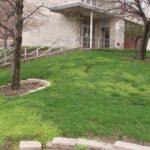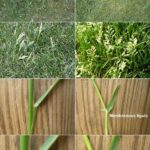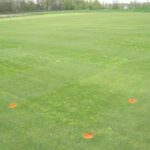Category: Weed Control
Attempting Ground Ivy Control
Ground ivy remains one of our toughest weeds to control. Following is our recommendation for maximizing control, based on experience and seven years of research: 1. Mow at 3” or higher. 2. Remove as much of the shade as possible. 3. Increase fertilizer up to 4.0 lbs N/1000ft2/yr fertilizing primarily in the fall 4. Make […]
Spring Dandelion Control Still Not as Effective as Fall Control
The annual bloom of dandelions is already here in southern and central Indiana. This marks the beginning of the second most effective period for controlling broadleaf weeds. The optimum time to control dandelions and other broadleaf weeds is in the fall and the second most effective time is in late spring, at or shortly after […]
Common Chickweed in New Seedlings
Common chickweed is currently dominating any fall- or dormant-seedings (including my lawn). Common chickweed is a winter annual, so it germinated last fall, grew well into December and is starting to spread with the temperatures this weekend (see accompanying photos). In established lawns, I wouldn’t recommend spraying it because it will die with the first […]
Spring Weed Control or Seeding?
With last year’s brutal summer and early fall, many areas are in need of reseeding. The question comes up about seeding and weed control: should the weeds be controlled first or should the seeding be done first? This seems like a simple question, but it’s fairly complex depending on the turf and weed species present […]
Herbicide Delays after Seeding
Almost all herbicides will affect turfgrass seedlings and application delays are usually needed following seeding. Following is information gleaned from available labels of most herbicides or herbicide types that would be used in Indiana. This is intended to provide a general idea of the limitations of each active ingredient, but please refer to the actual […]
Timing of Preemergence Herbicides
If a preemergence herbicide is justified on a turf area, the timing of application is important. In theory, applying too early will expose the herbicide to soil microbes and processes in the soil that may break it down, allowing crabgrass to germinate during the latter part of the summer. Conversely, applying too late may miss […]
Choose Preemergence herbicides with as Little N as Possible
If a preemergence herbicide is justified on your lawn to control crabgrass now, most of those are available combined with fertilizer and you are forced to apply a fertilizer now. Look for a product with low nitrogen and be sure the majority of the nitrogen is a slow release N. Slow release sources include sulfur- […]
Now is the Time to Control Dandelions
Those dandelions, clover, and other broadleaf weeds that were a problem all summer should be controlled this fall. The period from late September through October is the ideal time to control broadleaf weeds in turfgrass because broadleaf weeds are most susceptible to herbicides at this time. The turf and weeds must be green and actively […]
Turf 101: Why are broadleaf herbicides more effective in the fall than spring?
Late September through October is the best time to control weeds like dandelion, clover, and chickweed with an application of a broadleaf weed herbicide. Broadleaf weed herbicides are systemic and move through the plant in the phloem, which also transports photosynthate. The more areas of the plant that the herbicide translocates to, the more effective […]
No Rush on Broadleaf Weed Applications
After the rains have returned, broadleaf weed herbicides should become effective. However, don’t be in too much of a rush to apply because our data suggests that better control is obtained with October applications in than in September. We found that herbicides applied from October 1 through November 1 improved long-term ground ivy control compared […]
Controlling Sandbur
The dry summer allowed sandbur to get a competitive edge over the other lawn grasses on the sandy soils in northern Indiana. Most people don’t realize they have sandbur in their lawn until they come into painful contact with it, and unfortunately it is too late to do anything about it then. Sandbur is an […]
Banner Year for Crabgrass and Nutsedge
With the heat and humidity of this summer, our cool-season grasses continue to thin making it one of the better years in recent memory for crabgrass and nutsedge. In Lafayette, we’ve had 50 days of temperatures higher than 85F, 18 of which were over 90F. Maximum photosynthesis and shoot growth of cool-season grasses occur between […]
Overseeding creeping bentgrass into thinning Poa annua
Dry and hot conditions may unfortunately favor early exit of Poa annua from golf turf. However, there is a silver lining to this. Rutgers reported that overseeding creeping bentgrass directly into a Poa stand in summer is effective for gradual conversion when done July 1. Rutgers produced significant (>25% cover) of bentgrass within 12 months […]
Velocity for Poa annua control….Potential and Precautions
Velocity (byspribac) was registered for Poa annua control in creeping bentgrass last November, so this is the first summer of potential widespread use. As with all new pesticides, we’ll learn more of the finer details as we use it. We have a number of studies at Purdue currently and I just stopped at a course […]
Quicksilver Receives 24C Registration for Moss on Greens in Indiana
FMC’s QuickSilver T&O herbicide has just received special local 24(c) registration for control of silvery thread moss in putting greens in Indiana. Though Quicksilver (carfentrazone) is used widely as a quick knockdown contact broadleaf herbicide, it has good efficacy on silvery thread moss. The recommended rate for moss is 6.7 fluid oz/A (0.154 oz/1000 ft2 followed […]
Which is it, Annual Bluegrass or Kentucky Bluegrass?
Kentucky bluegrass is currently producing seedheads that are difficult to mow and create an uneven appearance. However, annual bluegrass (Poa annua) is also producing similar looking seedheads. It’s important to distinguish the two because Kentucky bluegrass is highly desirable in a lawn, but annual bluegrass is a weed. It is a weed because it is […]
Annual bluegrass (Poa annua) in Full Bloom in Lawns and Athletic Fields
Annual bluegrass is now very common in lawns and athletic fields, though it has been a problem on golf courses for years. Annual bluegrass is a lighter green than Kentucky bluegrass and perennial ryegrass, and will thin and die during the heat and drought of August in Indiana. It’s especially noticeable now because of it’s […]
Bentgrass Species and Cultivar Selection Impacts Annual Bluegrass Invasion in Renovated Bentgrass Fairways
Along with the warmer spring temperatures two things are certain; crabgrass will eventually germinate and annual bluegrass will profusely flower. For anyone managing bentgrass fairways or considering a bentgrass fairway renovation some of our recent research results will be of particular interest and provide some food for thought. There has been some mild interest in […]
Time is Running Out for Preemergence Control of Crabgrass
The below average temperatures the last few days has delayed crabgrass germination and thus premergence annual grass herbicides should still be effective if applied this week in the northern half to 2/3rds of the state. Most of the preemergence herbicides do have some post-emergence properties that will burn back small crabgrass (one or two leaf […]
Watch for Breakthrough from Early Preemergence Herbicide Applications
The extremely dry spring may reduce the effectiveness of preemergence herbicides. The products must be watered-in or rained-in to move them below the canopy and down to the soil where they will be effective. Herbicides not watered-in may also photodegrade faster than those wateredin. Early research showed a 44% loss in three days of preemergence […]



